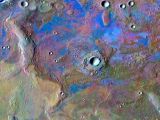Images relayed back to Earth in 2001 by the Mars Odyssey Thermal Emission Imaging System, or THEMIS for short, on board the Mars Reconnaissance Orbiter, seem to have recently fallen back into the scientists' attention. Hundreds of small depressions on the surface of Mars reveal salt deposits similar to those found on Earth when water evaporates. The study was conducted at the University of Hawaii by researcher Mikki Osterloo.
Osterloo strongly believes that the new evidence found by his team is yet a new confirmation of the theory that Mars might have had liquid water on its surface at some point in time. Alternatively, the discovery of chloride minerals on the surface of Mars gives a serious boost to the theory that life could have appeared on the Red Planet and uniquely adapted to the harsh conditions.
The reason for such beliefs is simple, as life on Earth is greatly dependent of salt minerals to survive. While studying the images of Mars' surface, the investigating team realized that they presented subtle differences in the composition of the soil. A closer look later revealed about 200 individual mineral deposits, some of the smallest spreading on a total area of 26 square kilometers. And the features are not local, in fact they are spread throughout the whole surface of Mars.
The locations of the deposits show that they could have formed 3.8 billion years ago while others appear to be up to a few hundred thousand years younger. Back here on Earth, salt deposits form when large bodies of water evaporate, leaving behind the suspensions that were dissolved in it. Alternatively, similar salt deposits may form in underground brines as a result of water evaporation due to volcanic activity.
Osterloo says that on Mars the most likely formation process involved the evaporation of acidic fluids during interactions with basaltic rock. "In order to support the theory of an early wet Mars, I think we need to continue to send ground truth missions as well as orbital instruments," said Osterloo.
Paul Knauth, geologist at Arizona State University says "It's about time they teased salt deposits out of the remote-sensing data! Gary Brass showed over 25 years ago that concentrated brines could be stable there." Aside the study released by Gary Brass of University of Miami in 1980, a paper published by Knauth seven years ago revealed the reason why such brines should exist on Mars.
The finding is significant, however the idea of chlorides on Mars is not very new. Naturally, nobody is surprised. Recently, the HiRISE camera on board the Mars Reconnaissance Orbiter revealed the presence of swirling patterns of salt-marsh, which could preserve organic material and substances precursors to life - if any is there.

 14 DAY TRIAL //
14 DAY TRIAL // 
